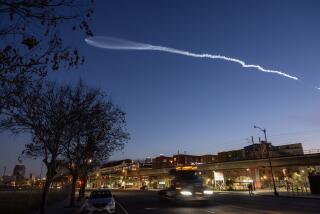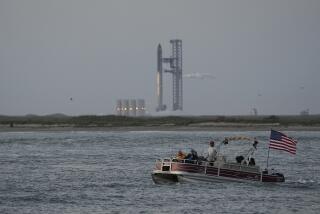Second Success in Two Weeks : Laser Tracks Rocket Hurtling Into Space in ‘Star Wars’ Test
- Share via
WASHINGTON — Ground-based, low-power laser beams tracked a rocket hurtling into space in the second successful experiment related to the “Star Wars” missile defense system in two weeks, the Pentagon announced Thursday.
The experiment with a Terrier-Malemute rocket and two laser beams was conducted Oct. 10, but bureaucratic delays within the Pentagon held up the announcement, a Pentagon official said.
The purpose of the tests is to demonstrate that laser beams can be fired through the atmosphere without being blocked or distorted.
As in the first test Sept. 27, the rocket was launched from the Navy’s Pacific Missile Range Facility in Hawaii. Two visible argon-ion laser beams were then fired from the Air Force Optical Site on the island of Maui, the Pentagon said. Only one beam was fired in the first test.
Argon is bluish-red, appears in the atmosphere and is used in electric light bulbs. The rocket was not harmed by the beams.
“The highly successful experiment allowed scientists to receive both a signal from the retroreflector and telemetry data from . . . the rocket, which confirmed that a high-quality beam had reached the rocket,” a Pentagon statement said.
Ground and space-based lasers, whose beams may be reflected toward their targets from mirrors orbiting in space, are part of the complex Strategic Defense Initiative or “Star Wars” system envisioned by planners to destroy nuclear-armed missiles and their warheads before they reach their targets.
More to Read
Sign up for Essential California
The most important California stories and recommendations in your inbox every morning.
You may occasionally receive promotional content from the Los Angeles Times.









